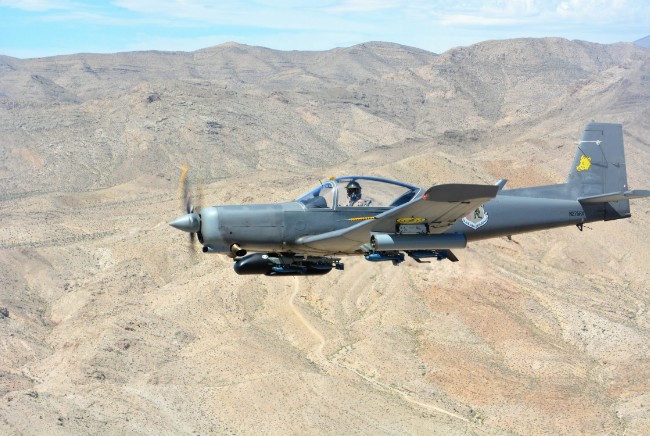
Blue Air Training will provide close air support training services to the Air Force under an Oct. 18, 2019 contract, largely using its A-90 Raider light-attack turboprop aircraft. Photo courtesy of Blue Air Training.?
The Air Force is moving forward with a plan to further privatize Red Air services with a contract worth up to $6.4 billion.
Seven companies are receiving a piece of the Oct. 18 award: Air USA, Airborne Tactical Advantage Company, Blue Air Training, Coastal Defense, Draken International, Tactical Air Support, and Top Aces Corp. Eight companies bid on the contract, which is expected to provide more realistic threat training to airmen than blue-suit pilots outside the dedicated aggressor squadrons currently offer.
“Contractors will provide complete contracted air support services for realistic and challenging advanced adversary air threats and close air support threats,” according to a Defense Department announcement. Their contributions span “aircraft, unmanned aircraft systems, aircraft systems support, pilots, aircraft maintenance, support equipment” and other management through Oct. 29, 2024.
Air Force Magazine previously reported the contract—which is helping spur the rise of a new industry—would cover adversary training that is split between about 50,000 hours of adversary air and joint terminal attack controller training. Those selected companies can now compete for task orders to support individual bases with their own unique requirements.
The recent award could shape how the service approaches adversary air training for good, though others argue new technologies like augmented reality can play a role in Red Air as well.
Companies cheered the contract’s arrival, which has been expected since the beginning of the year.
“Over the past four years, Draken International has helped the men and women of the USAF grow a commercial ADAIR program that currently supports Nellis AFB [in Nevada], as well as 10 other Air Force operating locations throughout [the continental US] and Alaska,” said Scott Poteet, Draken’s director of Air Force programs. “This industry has proven to enhance combat readiness for the warfighter and will continue to grow with the [combat Air Forces close air support] contract as support broadens throughout the Air Force and potentially other DOD services. This invaluable service will ultimately save hundreds of millions of taxpayer dollars.”
Blue Air Training said Oct. 22 it will focus on the contract’s CAS component from its facilities in Nevada, Arizona, and Florida, largely using its A-90 Raider light-attack turboprop aircraft.
“We spend countless hours studying current tactics for any fighter a JTAC could see operationally and utilize those tactics, techniques and procedures in the training scenarios so the JTACs feel as if the actual asset is on station,” said James Barlow, Blue Air Training’s founder and chief executive officer. “A light-attack asset such as the A-90 Raider can easily simulate an A-10, F-16, or F-35 because tactically, JTACs don’t spend much time looking at the aircraft.”
The companies will now vie for task orders at 22 locations, including 12 for adversary air and 10 for contract close air support, according to ATAC, a Textron subsidiary.
